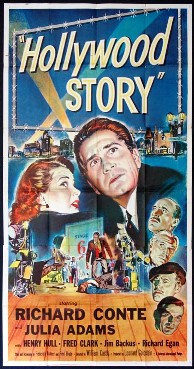| Hollywood Story | |
|---|---|
 Theatrical release poster | |
| Directed by | William Castle |
| Written by | Frederick Brady Frederick Kohner |
| Produced by | Leonard Goldstein |
| Starring | Richard Conte Julia Adams Richard Egan Henry Hull Fred Clark Jim Backus |
| Cinematography | Carl E. Guthrie |
| Edited by | Virgil Vogel |
| Color process | Black and white |
Production company | Universal Pictures |
| Distributed by | Universal Pictures |
Release date |
|
Running time | 77 minutes |
| Country | United States |
| Language | English |
Hollywood Story is a 1951 American mystery film directed by William Castle and starring Richard Conte and Julia Adams. [1] The supporting cast features Richard Egan, Henry Hull, Fred Clark and Jim Backus.
Contents
The film was an attempt by Universal Pictures to take advantage of the success of Paramount's Sunset Boulevard which was released the previous year. Film historian Arthur Lyons stated that the plot is based on the murder of silent movie director William Desmond Taylor. [2] While Hollywood Story reaches a fictional conclusion, it closely follows the circumstances of the real-life event.
On the film's release, Universal promoted the appearances in it of several once-famous silent screen celebrities. It came to light that those with speaking parts had received just $55 per shooting day ($666 in 2024 dollars [3] ). Others, like Elmo Lincoln, the first screen Tarzan, appeared as non-speaking extras and received only $15 per day ($182 in 2024 dollars [3] ). [2]